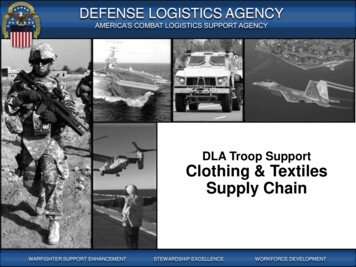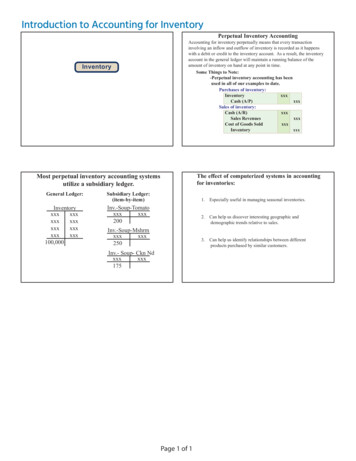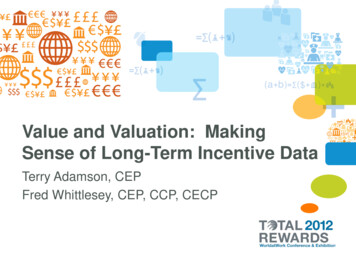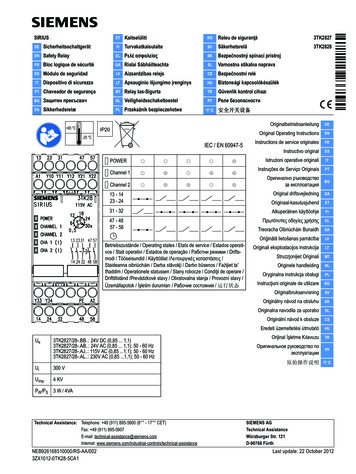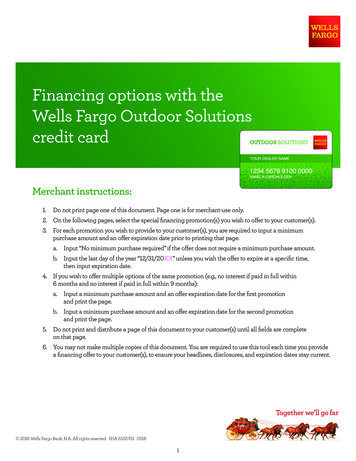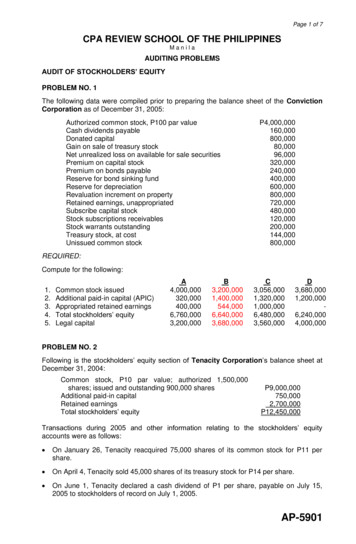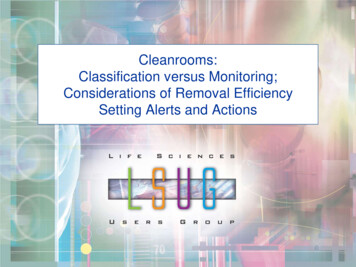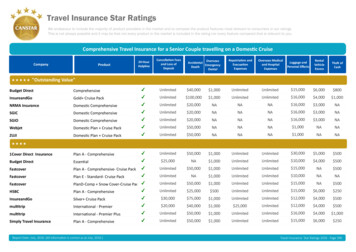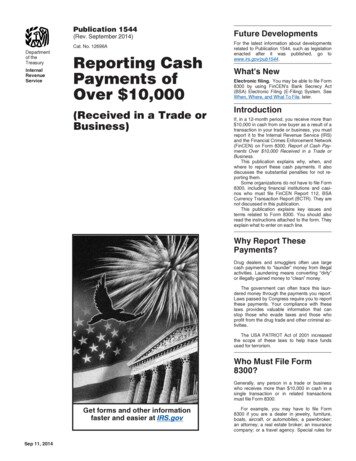
Transcription
Publication 1544(Rev. September 2014)Departmentof theTreasuryInternalRevenueServiceCat. No. 12696AReporting CashPayments ofOver 10,000(Received in a Trade orBusiness)Future DevelopmentsFor the latest information about developmentsrelated to Publication 1544, such as legislationenacted after it was published, go towww.irs.gov/pub1544.What's NewElectronic filing. You may be able to file Form8300 by using FinCEN's Bank Secrecy Act(BSA) Electronic Filing (E-Filing) System. SeeWhen, Where, and What To File, later.IntroductionIf, in a 12-month period, you receive more than 10,000 in cash from one buyer as a result of atransaction in your trade or business, you mustreport it to the Internal Revenue Service (IRS)and the Financial Crimes Enforcement Network(FinCEN) on Form 8300, Report of Cash Pay ments Over 10,000 Received in a Trade orBusiness.This publication explains why, when, andwhere to report these cash payments. It alsodiscusses the substantial penalties for not reporting them.Some organizations do not have to file Form8300, including financial institutions and casinos who must file FinCEN Report 112, BSACurrency Transaction Report (BCTR). They arenot discussed in this publication.This publication explains key issues andterms related to Form 8300. You should alsoread the instructions attached to the form. Theyexplain what to enter on each line.Why Report ThesePayments?Drug dealers and smugglers often use largecash payments to “launder” money from illegalactivities. Laundering means converting “dirty”or illegally-gained money to “clean” money.The government can often trace this laundered money through the payments you report.Laws passed by Congress require you to reportthese payments. Your compliance with theselaws provides valuable information that canstop those who evade taxes and those whoprofit from the drug trade and other criminal activities.The USA PATRIOT Act of 2001 increasedthe scope of these laws to help trace fundsused for terrorism.Who Must File Form8300?Generally, any person in a trade or businesswho receives more than 10,000 in cash in asingle transaction or in related transactionsmust file Form 8300.Get forms and other informationfaster and easier at IRS.govSep 11, 2014For example, you may have to file Form8300 if you are a dealer in jewelry, furniture,boats, aircraft, or automobiles; a pawnbroker;an attorney; a real estate broker; an insurancecompany; or a travel agency. Special rules for
clerks of federal or state courts are discussedlater under Bail received by court clerks.However, you do not have to file Form 8300if the transaction is not related to your trade orbusiness. For example, if you own a jewelrystore and sell your personal automobile formore than 10,000 in cash, you would not submit a Form 8300 for that transaction.Transaction defined. A “transaction” occurswhen:Goods, services, or property are sold;Property is rented;Cash is exchanged for other cash;A contribution is made to a trust or escrowaccount;A loan is made or repaid; orCash is converted to a negotiable instrument, such as a check or a bond.Person defined. A “person” includes an individual, a company, a corporation, a partnership,an association, a trust, or an estate.Exempt organizations, including employeeplans, are also “persons.” However, exempt organizations do not have to file Form 8300 for amore-than- 10,000 charitable cash contributionthey receive since it is not received in thecourse of a trade or business.Foreign transactions. You do not have to fileForm 8300 if the entire transaction (includingthe receipt of cash) takes place outside of:The 50 states,The District of Columbia,Puerto Rico, orA possession or territory of the UnitedStates.However, you must file Form 8300 if any part ofthe transaction (including the receipt of cash)occurs in Puerto Rico or a possession or territory of the United States and you are subject tothe Internal Revenue Code.Bail received by court clerks. Any clerk of afederal or state court who receives more than 10,000 in cash as bail for an individualcharged with any of the following criminal offenses must file Form 8300:1. Any federal offense involving a controlledsubstance,2. Racketeering,initial payment to total more than 10,000, orc. Other previously unreportable payments that cause the total cash received within a 12-month period to total more than 10,000,3. Received in the course of your trade orbusiness,4. Received from the same buyer (or agent),and5. Received in a single transaction or in related transactions (defined later).What Is Cash?Cash is:1. The coins and currency of the UnitedStates (and any other country), and2. A cashier's check, bank draft, traveler'scheck, or money order you receive, if ithas a face amount of 10,000 or less andyou receive it in:a. A designated reporting transaction(defined later), orb. Any transaction in which you know thepayer is trying to avoid the reporting ofthe transaction on Form 8300.!CAUTIONCash may include a cashier's checkeven if it is called a “treasurer's check”or “bank check.”Cash does not include a check drawn on anindividual's personal account.A cashier's check, bank draft, traveler'scheck, or money order with a face amount ofmore than 10,000 is not treated as cash.These items are not defined as cash and youdo not have to file Form 8300 when you receivethem because, if they were bought with currency, the bank or other financial institution thatissued them must file a report on FinCEN Report 112.Example 1. You are a coin dealer. BobGreen buys gold coins from you for 13,200.He pays for them with 6,200 in U.S. currencyand a cashier's check having a face amount of 7,000. The cashier's check is treated as cash.You have received more than 10,000 cashand must file Form 8300 for this transaction.1. A consumer durable, such as an automobile or boat. A consumer durable is property, other than land or buildings, that:a. Is suitable for personal use,b. Can reasonably be expected to last atleast 1 year under ordinary use,c. Has a sales price of more than 10,000, andd. Can be seen or touched (tangibleproperty).For example, a 20,000 car is a consumer durable, but a 20,000 dump truckor factory machine is not. The car is a consumer durable even if you sell it to a buyerwho will use it in a business.2. A collectible (for example, a work of art,rug, antique, metal, gem, stamp, or coin).3. Travel or entertainment, if the total salesprice of all items sold for the same trip orentertainment event in one transaction (orrelated transactions) is more than 10,000.To figure the total sales price of all itemssold for a trip or entertainment event, you include the sales price of items such as airfare,hotel rooms, and admission tickets.Example. You are a travel agent. Ed Johnson asks you to charter a passenger airplane totake a group to a sports event in another city.He also asks you to book hotel rooms and admission tickets for the group. In payment, hegives you two money orders, each for 6,000.You have received more than 10,000 cash inthis designated reporting transaction. You mustfile Form 8300.Retail sale. The term “retail sale” means anysale made in the course of a trade or businessthat consists mainly of making sales to ultimateconsumers.Thus, if your business consists mainly ofmaking sales to ultimate consumers, all salesyou make in the course of that business are retail sales. This includes any sales of items thatwill be resold.Broker or intermediary. A designated reporting transaction includes the retail sale of items(1), (2), or (3) of the preceding list, even if thefunds are received by a broker or other intermediary, rather than directly by the seller.Example 2. You are a retail jeweler. MaryNorth buys an item of jewelry from you for 12,000. She pays for it with a personal checkpayable to you in the amount of 9,600 andtraveler's checks totaling 2,400. Because thepersonal check is not treated as cash, you havenot received more than 10,000 cash in thetransaction. You do not have to file Form 8300.A cashier's check, bank draft, traveler's check,or money order you received in a designated reporting transaction is not treated as cash if oneof the following exceptions applies.Example 3. You are a boat dealer. EmilyJones buys a boat from you for 16,500. Shepays for it with a cashier's check payable to youin the amount of 16,500. The cashier's checkis not treated as cash because its face amountis more than 10,000. You do not have to fileForm 8300 for this transaction.Exception for certain bank loans. A cashier's check, bank draft, traveler's check, ormoney order is not treated as cash if it is theproceeds from a bank loan. As proof that it isfrom a bank loan, you may rely on a copy of theloan document, a written statement or lien instruction from the bank, or similar proof.a. One lump sum of over 10,000,Designated Reporting Transactionb. Installment payments that cause thetotal cash received within 1 year of theA designated reporting transaction is the retailsale of any of the following:Example. You are a car dealer. MandyWhite buys a new car from you for 11,500.She pays you with 2,000 of U.S. currency anda cashier's check for 9,500 payable to you and3. Money laundering, and4. Any state offense substantially similar to(1), (2), or (3) above.For more information about the rules that applyto court clerks, see Section 1.6050I-2 of the Income Tax Regulations.What Payments Must BeReported?You must file Form 8300 to report cash paid toyou if it is:1. Over 10,000,2. Received as:Page 2Exceptions to Definition of CashPublication 1544 (September 2014)
her. You can tell that the cashier's check is theproceeds of a bank loan because it includes instructions to you to have a lien put on the car assecurity for the loan. For this reason, the cashier's check is not treated as cash. You do nothave to file Form 8300 for the transaction.Exception for certain installment sales. Acashier's check, bank draft, traveler's check, ormoney order is not treated as cash if it is received in payment on a promissory note or aninstallment sales contract (including a lease thatis considered a sale for federal tax purposes).However, this exception applies only if:1. You use similar notes or contracts in othersales to ultimate consumers in the ordinary course of your trade or business, and2. The total payments for the sale that youreceive on or before the 60th day after thesale are 50% or less of the purchase price.Exception for certain down payment plans.A cashier's check, bank draft, traveler's check,or money order is not treated as cash if you received it in payment for a consumer durable orcollectible, and all three of the following statements are true.1. You receive it under a payment plan requiring:a. One or more down payments, andb. Payment of the rest of the purchaseprice by the date of sale.2. You receive it more than 60 days beforethe date of sale.3. You use payment plans with the same orsubstantially similar terms when selling toultimate consumers in the ordinary courseof your trade or business.Exception for travel and entertainment. Acashier's check, bank draft, traveler's check, ormoney order received for travel or entertainment is not treated as cash if all three of the following statements are true.1. You receive it under a payment plan requiring:a. One or more down payments, andb. Payment of the rest of the purchaseprice by the earliest date that anytravel or entertainment item (such asairfare) is furnished for the trip or entertainment event.2. You receive it more than 60 days beforethe date on which the final payment is due.3. You use payment plans with the same orsubstantially similar terms when selling toultimate consumers in the ordinary courseof your trade or business.Taxpayer IdentificationNumber (TIN)You must furnish the correct TIN of the personor persons from whom you receive the cash. Ifthe transaction is conducted on the behalf ofanother person or persons, you must furnish theTIN of that person or persons. If you do notknow a person's TIN, you have to ask for it. Youmay be subject to penalties for an incorrect ormissing TIN.Publication 1544 (September 2014)There are three types of TINs.1. The TIN for an individual, including a soleproprietor, is the individual's social security number (SSN).2. The TIN for a nonresident alien individualwho needs a TIN but is not eligible to getan SSN is an IRS individual taxpayer identification number (ITIN). An ITIN has ninedigits, similar to an SSN.3. The TIN for other persons, including corporations, partnerships, and estates, is theemployer identification number (EIN).Exception. You are not required to provide theTIN of a person who is a nonresident alien individual or a foreign organization if that person orforeign organization:1. Does not have income effectively connected with the conduct of a U.S. trade orbusiness;2. Does not have an office or place of business, or a fiscal or paying agent in the United States;3. Does not file a federal tax return;4. Does not furnish a withholding certificatedescribed in §1.1441-1(e)(2) or (3) or1.1441-5(c)(2)(iv) or (3)(iii) to the extentrequired under 1.1441-1(e)(4)(vii);5. Does not have to furnish a TIN on any return, statement, or other document as required by the income tax regulations undersection 897 or 1445; or6. In the case of a nonresident alien individual, the individual has not chosen to file ajoint federal income tax return with aspouse who is a U.S. citizen or resident.What Is a RelatedTransaction?Any transactions between a buyer (or an agentof the buyer) and a seller that occur within a24-hour period are related transactions. If youreceive over 10,000 in cash during two ormore transactions with one buyer in a 24-hourperiod, you must treat the transactions as onetransaction and report the payments on Form8300.For example, if you sell two products for 6,000 each to the same customer in 1 day andthe customer pays you in cash, these are related transactions. Because they total 12,000(more than 10,000), you must file Form 8300.More than 24 hours between transactions.Transactions are related even if they are morethan 24 hours apart if you know, or have reasonto know, that each is one of a series of connected transactions.For example, you are a travel agent. A clientpays you 8,000 in cash for a trip. Two dayslater, the same client pays you 3,000 more incash to include another person on the trip.These are related transactions, and you mustfile Form 8300 to report them.What About SuspiciousTransactions?If you receive 10,000 or less in cash, you mayvoluntarily file Form 8300 if the transaction appears to be suspicious.A transaction is suspicious if it appears thata person is trying to cause you not to file Form8300 or is trying to cause you to file a false orincomplete Form 8300, or if there is a sign ofpossible illegal activity.If you are suspicious, you are encouraged tocall the local IRS Criminal Investigation Divisionas soon as possible. Or, you can call the FinCEN Financial Institution Hotline toll free at1-866-556-3974.When, Where, and WhatTo FileThe amount you receive and when you receiveit determine when you must file. Generally, youmust file Form 8300 within 15 days after receiving a payment. If the Form 8300 due date (the15th or last day you can timely file the form) fallson a Saturday, Sunday, or legal holiday, it is delayed until the next day that is not a Saturday,Sunday, or legal holiday.More than one payment. In some transactions, the buyer may arrange to pay you in cashinstallment payments. If the first payment ismore than 10,000, you must file Form 8300within 15 days. If the first payment is not morethan 10,000, you must add the first paymentand any later payments made within 1 year ofthe first payment. When the total cash payments are more than 10,000, you must fileForm 8300 within 15 days.After you file Form 8300, you must start anew count of cash payments received from thatbuyer. If you receive more than 10,000 in additional cash payments from that buyer within a12-month period, you must file another Form8300. You must file the form within 15 days ofthe payment that causes the additional payments to total more than 10,000.If you are already required to file Form 8300and you receive additional payments within the15 days before you must file, you can report allthe payments on one form.Example. On January 10, you receive acash payment of 11,000. You receive additional cash payments on the same transactionof 4,000 on February 15, 5,000 on March 20,and 6,000 on May 12. By January 25, youmust file a Form 8300 for the 11,000 payment.By May 27, you must file an additional Form8300 for the additional payments that total 15,000.Amending a Report? If you are amending areport, check box 1a at the top of Form 8300.Complete the form in its entirety (Parts I-IV) andinclude the amended information. Do not attacha copy of the original report.Where to file. Mail the form to the addressgiven in the Form 8300 instructions.You may file the form electronically by usingFinCEN's BSA E-Filing System. To get more information, visit bsaefiling.fincen.treas.gov.Page 3
Required statement to buyer. You must givea written or electronic statement to each personnamed on any Form 8300 you must file. Youcan give the statement electronically only if therecipient agrees to receive it in that format. Thestatement must show the name and address ofyour business, the name and phone number ofa contact person, and the total amount of reportable cash you received from the personduring the year. It must state that you are alsoreporting this information to the IRS.You must send this statement to the buyerby January 31 of the year after the year in whichyou received the cash that caused you to filethe form.You must keep a copy of every Form8300 you file for 5 years.RECORDSExamplesExample 1. Pat Brown is the sales manager for Small Town Cars. On January 6, 2015,Jane Smith buys a new car from Pat and pays 18,000 in cash. Pat asks for identification fromJane to get the necessary information to complete Form 8300. A filled-in form is shown in thispublication.Pat must mail the form to the address shownin the form's instructions or file the form electronically using FinCen's BSA E-Filing Systemby January 21, 2015. He must also send astatement to Jane by January 31, 2016.Example 2. Using the same facts given inExample 1, suppose Jane had arranged tomake cash payments of 6,000 each on January 6, February 6, and March 6. Pat would haveto file a Form 8300 by February 23 (17 days after receiving total cash payments within 1 yearover 10,000 because February 21, 2015, is aSaturday). Pat would not have to report the remaining 6,000 cash payment because it is notmore than 10,000. However, he could report itif he felt it was a suspicious transaction.PenaltiesThere are civil penalties for failure to:File a correct Form 8300 by the date it isdue, andProvide the required statement to thosenamed in the Form 8300.If you intentionally disregard the requirementto file a correct Form 8300 by the date it is due,the penalty is the greater of:1. 25,000, or2. The amount of cash you received andwere required to report (up to 100,000).There are criminal penalties for:Willful failure to file Form 8300,Willfully filing a false or fraudulent Form8300,Stopping or trying to stop Form 8300 frombeing filed, andSetting up, helping to set up, or trying toset up a transaction in a way that wouldmake it seem unnecessary to file Form8300.If you willfully fail to file Form 8300, you canbe fined up to 250,000 for individualsPage 4( 500,000 for corporations) or sentenced to upto 5 years in prison, or both. These dollaramounts are based on Section 3571 of Title 18of the U.S. Code.The penalties for failure to file may also apply to any person (including a payer) who attempts to interfere with or prevent the seller (orbusiness) from filing a correct Form 8300. Thisincludes any attempt to structure the transaction in a way that would make it seem unnecessary to file Form 8300. Structuring meansbreaking up a large cash transaction into smallcash transactions.How To Get Tax HelpWhether it's help with a tax issue, preparingyour tax return or a need for a free publicationor form, get the help you need the way you wantit: online, use a smart phone, call or walk in toan IRS office or volunteer site near you.Free help with your tax return. You can getfree help preparing your return nationwide fromIRS-certified volunteers. The Volunteer IncomeTax Assistance (VITA) program helpslow-to-moderate income, elderly, people withdisabilities, and limited English proficient taxpayers. The Tax Counseling for the Elderly(TCE) program helps taxpayers age 60 andolder with their tax returns. Most VITA and TCEsites offer free electronic filing and all volunteers will let you know about credits and deductions you may be entitled to claim. In addition,some VITA and TCE sites provide taxpayersthe opportunity to prepare their own return withhelp from an IRS-certified volunteer. To find thenearest VITA or TCE site, you can use the VITALocator Tool on IRS.gov, download the IRS2Goapp, or call 1-800-906-9887.As part of the TCE program, AARP offersthe Tax-Aide counseling program. To find thenearest AARP Tax-Aide site, visit AARP's website at www.aarp.org/money/taxaide or call1-888-227-7669. For more information on theseprograms, go to IRS.gov and enter “VITA” in thesearch box.Internet. IRS.gov and IRS2Go are readywhen you are —24 hours a day, 7 days a week.Download the free IRS2Go app from theiTunes app store or from Google Play. Useit to check your refund status, order transcripts of your tax returns or tax account,watch the IRS YouTube channel, get IRSnews as soon as it's released to the public,subscribe to filing season updates or dailytax tips, and follow the IRS Twitter newsfeed, @IRSnews, to get the latest federaltax news, including information about taxlaw changes and important IRS programs.Check the status of your 2013 refund withthe Where's My Refund? application onIRS.gov or download the IRS2Go app andselect the Refund Status option. The IRSissues more than 9 out of 10 refunds inless than 21 days. Using these applications, you can start checking on the statusof your return within 24 hours after we receive your e-filed return or 4 weeks afteryou mail a paper return. You will also begiven a personalized refund date as soonas the IRS processes your tax return andapproves your refund. The IRS updatesWhere's My Refund? every 24 hours, usu-ally overnight, so you only need to checkonce a day.Use the Interactive Tax Assistant (ITA) toresearch your tax questions. No need towait on the phone or stand in line. The ITAis available 24 hours a day, 7 days a week,and provides you with a variety of tax information related to general filing topics, deductions, credits, and income. When youreach the response screen, you can printthe entire interview and the final responsefor your records. New subject areas areadded on a regular basis.Answers not provided through ITA may befound in Tax Trails, one of the Tax Topicson IRS.gov which contain general individual and business tax information or bysearching the IRS Tax Map, which includes an international subject index.You can use the IRS Tax Map, to searchpublications and instructions by topic orkeyword. The IRS Tax Map integratesforms and publications into one researchtool and provides single-point access totax law information by subject. When theuser searches the IRS Tax Map, they willbe provided with links to related content inexisting IRS publications, forms and instructions, questions and answers, andTax Topics.Coming this filing season, you can immediately view and print for free all 5 types ofindividual federal tax transcripts (tax returns, tax account, record of account,wage and income statement, and certification of non-filing) using Get Transcript.You can also ask the IRS to mail a returnor an account transcript to you. Only themail option is available by choosing theTax Records option on the IRS2Go app byselecting Mail Transcript on IRS.gov or bycalling 1-800-908-9946. Tax return and taxaccount transcripts are generally availablefor the current year and the past threeyears.Determine if you are eligible for the EITCand estimate the amount of the credit withthe Earned Income Tax Credit (EITC)Assistant.Visit Understanding Your IRS Notice orLetter to get answers to questions about anotice or letter you received from the IRS.If you received the First Time HomebuyerCredit, you can use the First TimeHomebuyer Credit Account Look up toolfor information on your repayments and account balance.Check the status of your amended returnusing Where's My Amended Return? Go toIRS.gov and enter Where's My AmendedReturn? in the search box. You can generally expect your amended return to be processed up to 12 weeks from the date wereceive it. It can take up to 3 weeks fromthe date you mailed it to show up in oursystem.Make a payment using one of several safeand convenient electronic payment optionsavailable on IRS.gov. Select the Paymenttab on the front page of IRS.gov for moreinformation.Determine if you are eligible and apply foran online payment agreement, if you owemore tax than you can pay today.Figure your income tax withholding withthe IRS Withholding Calculator on IRS.gov.Use it if you've had too much or too littlewithheld, your personal situation hasPublication 1544 (September 2014)
changed, you're starting a new job or youjust want to see if you're having the rightamount withheld.Determine if you might be subject to the Alternative Minimum Tax by using theAlternative Minimum Tax Assistant onIRS.gov.Request an Electronic Filing PIN by going to IRS.gov and entering Electronic Fil ing PIN in the search box.Download forms, instructions and publications, including accessible versions forpeople with disabilities.Locate the nearest Taxpayer AssistanceCenter (TAC) using the Office Locator toolon IRS.gov, or choose the Contact Us option on the IRS2Go app and search LocalOffices. An employee can answer questions about your tax account or help youset up a payment plan. Before you visit,check the Office Locator on IRS.gov, orLocal Offices under Contact Us on IRS2Goto confirm the address, phone number,days and hours of operation, and the services provided. If you have a special need,such as a disability, you can request an appointment. Call the local number listed inthe Office Locator, or look in the phonebook under United States Government, Internal Revenue Service.Apply for an Employer IdentificationNumber (EIN). Go to IRS.gov and enterApply for an EIN in the search box.Read the Internal Revenue Code, regulations, or other official guidance.Read Internal Revenue Bulletins.Sign up to receive local and national taxnews and more by email. Just click on“subscriptions” above the search box onIRS.gov and choose from a variety of options.Phone. You can call the IRS, or you can carryit in your pocket with the IRS2Go app on yoursmart phone or tablet. Download the freeIRS2Go app from the iTunes app store or fromGoogle Play.Call to locate the nearest volunteer helpsite, 1-800-906-9887 or you can use theVITA Locator Tool on IRS.gov, or download the IRS2Go app. Low-to-moderate income, elderly, people with disabilities, andlimited English proficient taxpayers can getfree help with their tax return from the nationwide Volunteer Income Tax Assistance(VITA) program. The Tax Counseling forthe Elderly (TCE) program helps taxpayersage 60 and older with their tax returns.Most VITA and TCE sites offer free electronic filing. Some VITA and TCE sites provide IRS-certified volunteers who can helpprepare your tax return. Through the TCEprogram, AARP offers the Tax-Aide counseling program; call 1-888-227-7669 tofind the nearest Tax-Aide location.Call the automated Where's My Refund?information hotline to check the status ofyour 2013 refund 24 hours a day, 7 days aweek at 1-800-829-1954. If you e-file, youcan start checking on the status of your re-Publication 1544 (September 2014)turn within 24 hours after the IRS receivesyour tax return or 4 weeks after you'vemailed a paper return. The IRS issuesmore than 9 out of 10 refunds in less than21 days. Where's My Refund? will give youa personalized refund date as soon as theIRS processes your tax return and approves your refund. Before you call this automated hotline, have your 2013 tax returnhandy so you can enter your social security number, your filing status, and the exactwhole dollar amount of your refund. TheIRS updates Where's My Refund? every24 hours, usually overnight, so you onlyneed to check once a day. Note, the aboveinformation is for our automated hotline.Our live phone and walk-in assistors canresearch the status of your refund only ifit's been 21 days or more since you filedelectronically or more than 6 weeks sinceyou mailed your paper return.Call the Amended Return Hotline,1-866-464-2050, to check the status ofyour amended return. You can generallyexpect your amended return to be processed up to 12 weeks from the date wereceive it. It can take up to 3 weeks fromthe date you mailed it to show up in oursystem.Call 1-800-TAX-FORM (1-800-829-3676)to order current-year forms, instructions,publications, and prior-year forms and instructions (limited to 5 years). You shouldreceive your order within 10 businessdays.Call TeleTax, 1-800-829-4477, to listen topre-recorded messages covering generaland business tax information. If, betweenJanuary and April 15, you still have questions about the Form 1040, 1040A, or1040EZ (like filing requirements, dependents, credits, Schedule D, pensions andIRAs or self-employment taxes), call1-800-829-1040.Call using TTY/TDD equipment,1-800-829-4059 to ask tax questions or order forms and publications. The TTY/TDDtelephone number is for people who aredeaf, hard of hearing, or have a speechdisability. These individuals can also contact the IRS through relay ser
a. One lump sum of over 10,000, b. Installment payments that cause the total cash received within 1 year of the initial payment to total more than 10,000, or c. Other previously unreportable pay-ments that cause the total cash re-ceived within a 12-month period to to-tal more than 10,000

